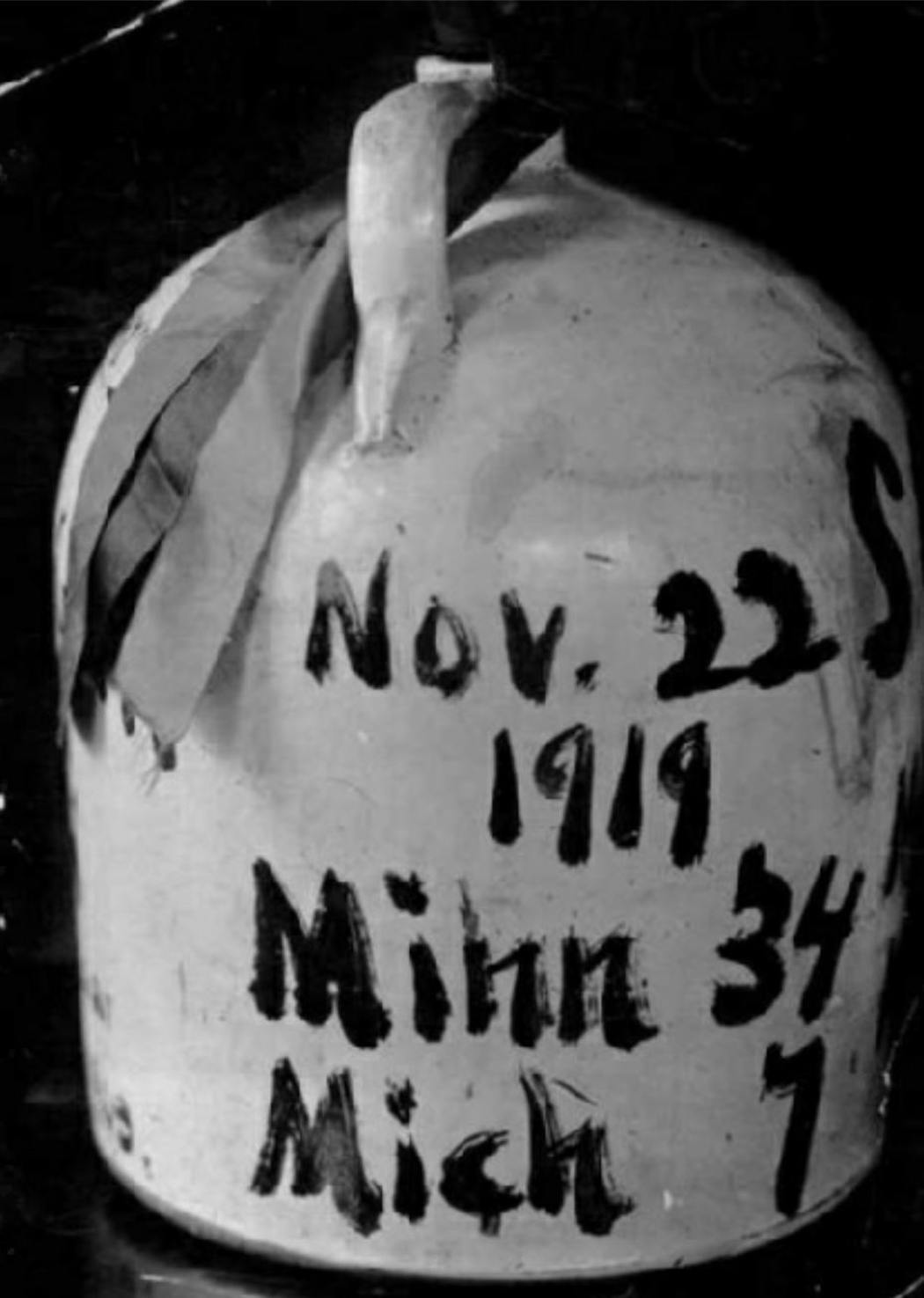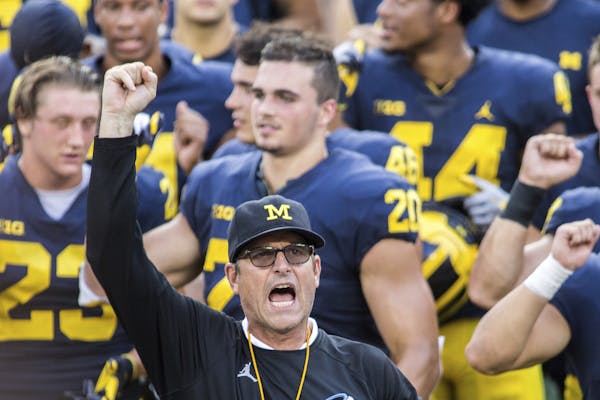World War I was raging in Europe, an influenza pandemic was moving around the globe. And so an incipient, but already intense, football rivalry was on hold.
It was 1918.
The University of Minnesota and Michigan had been set to renew the rivalry for the Little Brown Jug. The Gophers were coached by Henry Williams, Michigan by Fielding Yost, original players from the jug's inauguration as a traveling trophy.
It had been eight years since they last met, a gap created by Michigan's temporary exit from the Big Ten.
But Michigan was back, and the battle for the Little Brown Jug — the fabled, oldest-in-college-football trophy whose legend was still in its nascent stages — was about to be renewed.
It didn't happen.
As the Gophers prepare to face Michigan on Saturday in a season opener delayed by the COVID-19 outbreak, this 104th installment of the rivalry offers a chance to look back to another time college football faced a pandemic.
The deal-breaker for Minnesota and Michigan 102 years ago wasn't the deadly influenza outbreak, but the United States' involvement in World War I.
"They were scheduled to play a game in 1918," said Ken Magee, co-author with Jon M. Stevens of "The Little Brown Jug: The Michigan-Minnesota football rivalry." "There were travel restrictions. Not because of the flu, but because of the war effort."
The renewal of the rivalry would have to wait until 1919, when a stunning Gophers blowout brought the Jug to the Gophers' sideline for the first time.
The rivalry
It was 1903 when the Jug emerged. That year's game, played at Northrop Field, matched a Michigan team on a 29-game winning streak and a Gophers team that had won 38 of its past 45 games.
Worried his water supply might be compromised, Yost had student manager Thomas Roberts go to Dinkytown and buy a water jug, one Michigan left on the sidelines after the game. Play had been called off with time remaining after fans stormed the field after a late Gophers TD tied the score at 6.
The next day, Gophers custodian/equipment manager Oscar Munson brought the Jug to L.J. Cooke in the athletic department, saying, with his Scandinavian accent, "Yost left his yug."
Here's where legend and reality part, as Magee described in his book.
The legend grew that Yost demanded the Jug's return, to which the Gophers challenged Michigan to come win it. The truth is the Jug cost about 25 cents and Michigan probably just left it behind. But the Gophers painted the jug brown and wrote the score on it. The next time the teams met, in 1909, the two sides met the night before the game, agreeing the Jug might be a nice tradition, and the traveling trophy was born. Michigan won that year, and again in 1910.
War and pandemic
The first case of the deadly influenza strain was reported in Minneapolis on Sept. 27 of 1918.
By Oct. 12, the city had 1,538 reported cases. By the end of the outbreak 75,000 people in the city contracted the disease, according to former Star Tribune reporter Curt Brown's book, "Minnesota, 1918: When Flu, Fire, and War Ravaged the State."
But it was the war effort that both helped ignite the spread of the flu and caused drastic change to college football.
Because of the war effort, most large universities had become training grounds for soldiers in a program called Student Army Training Corps. Indeed, the Army at first intended to cancel the college football season so it wouldn't interfere with training.
Ultimately the Army relented but imposed a travel ban, essentially making extended road trips impossible. The Gophers played eight games, most at or close to home, including one against a local all-star squad and one against a North Dakota aviation station. But the game against Michigan was not played.
Meanwhile, the flu threat was growing. On Oct. 9 Minneapolis banned unnecessary meetings or gatherings, closing schools — something St. Paul did in November. Churches, pool halls, bowling alleys, theaters were closed.
The University of Minnesota initially postponed opening school until Oct. 9, eventually pushing the start until the 23rd.
"The campus was essentially closed to everyone except the SATC, and cadets were confined to campus," said Dr. Jennifer Gunn, an associate professor at the University of Minnesota medical school.
Gunn said Minnesotans initially were compliant with the shutdowns. Polio was in the recent past, and parents were afraid. Local Red Cross units were already making supplies for soldiers; they just switched to making masks.
"I think there was fear," Gunn said. "And I think there was, in some senses, a greater sense of compliance with the public health measures. There was a shared sense of a public good. But, as the flu seemed to let up, resistance to the measures grew."
Both the war and the flu were factors nationwide. Sixteen major college programs didn't play, including Alabama and LSU. The Missouri Valley Conference — which then included Kansas, Kansas State, Nebraska, Missouri and Iowa State — officially didn't play, though some teams, including Nebraska, went ahead with independent schedules.
Other sports were affected. The World Series, played early between the Boston Red Sox and Chicago Cubs, is thought by many to have contributed to a wave of flu in the Boston area. The 1919 Stanley Cup Final between the Seattle Metropolitans and Montreal Canadiens was called off after five games (2-2-1) when Montreal couldn't field a healthy team. A highly anticipated boxing match between Jack Dempsey and Battling Levinsky was postponed.
Taste of victory
But by 1919, with the war over and travel restrictions ended, the Michigan-Minnesota rivalry was back on, with a Nov. 22 meeting set in Michigan, the final game of the season for both teams.
The sports pages made no mention of the previous year's cancellation in the previews of the game, no mention of the pandemic, which was still an issue. Both Yost and Williams were on the sidelines, in front of 30,000 fans at Ferry Field in Ann Arbor. That was the largest recorded crowd to see a Gophers game in their history to that point, according to Minnesota's media guide.
With All-America back Arnold Oss leading the way with three scores, the Gophers won 34-7, marking the first time the Gophers had kept the Jug with a victory.
"When the Gophers asked for the symbolic trophy at the end of the game, their rivals couldn't find it," Minnesota's media guide says. "But the Gophers players persisted, and Wolverines equipment man Henry Hatch came up with it after a short time."
Cooke, Minnesota's AD, painted the score on the jug in large script, just as the Gophers had in 1903.
The 1919 Wolverines were 3-4, Yost's only losing record in 25 years as Michigan's coach; his teams would go 24-3-2 the following four seasons, winning the national title in 1923.
Still, it was one of the biggest conference losses Yost's team would endure. Minneapolis Sunday Tribune writer Fred Coburn put a poem above his story, and then this lead: "If revenge is sweet, then the Gophers of Minnesota are swimming in a saccharine solution tonight."
It wouldn't be sweet for long. Michigan defeated Minnesota 3-0 to win the Jug back in 1920 in front of a crowd of 23,000 at Northrop Field. The schools decided on a new paint job for the Jug, featuring the scores from each game of the rivalry. But the Gophers wouldn't win it back again until 1927, long after the ravages of the war and that pandemic had passed.
The Star Tribune's Joel Rippel and John Wareham contributed to this report.

Gophers women's athletics: This is what dominance looks like

Live: Twins vs. Angels. Follow the action on Gameview
Bevy of defensive playmakers are available in Round 2 of the NFL draft after historic offensive run

Live: Wolves vs. Suns in Game 3 of the playoffs. Follow it on Gameview.



